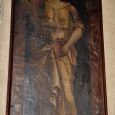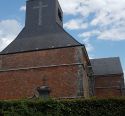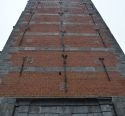Church | XVII | Romanesque, Gothic | Catholic Church




Map
Opening hours
01 January - 31 December
Mon 10.00 - 18.00
Tue 10.00 - 18.00
Wed 10.00 - 18.00
Thu 10.00 - 18.00
Fri 10.00 - 18.00
Sat 10.00 - 18.00
Sun 10.00 - 18.00
Religious offices
Find the Mass times for the parish of Sainte-Hiltrude en Avesnois on Messes.info
Description
In the 16th century, a parish church was built at the gates of the abbey. With its two defensive towers on its façade, the church served both as a shelter for the population and as protection from its powerful neighbour. Built with a small bell tower so as not to overshadow the sumptuous abbey church, Saint-Lambert church is typical of Avesnois churches. As soon as they enter, visitors are greeted by the abbey's motto "Servite Domino in Laeticia" and by Louis de Blois, a powerful abbot and close friend of Charles V. Today, many features bear witness to the history of the site, while others originate from the abbey itself.
The church has been listed as a Historic Monument since 1944.
Translated with www.DeepL.com/Translator (free version)
Photos
Remarkable elements
Wooden statues
The building is adorned with a number of wooden statues protected as Historic Monuments. Most were carved between the 16th and 18th centuries.
Translated with www.DeepL.com/Translator (free version)
Table of the 4 cardinal virtues
In the choir, four 18th-century paintings, protected as Historic Monuments since 1977, represent the four cardinal virtues.
They include :
- Temperance, represented by a woman passing water from one container to another,
- Justice, represented by a sword and scales,
- Strength with the helmeted woman,
- Prudence, symbolised by the snake and the mirror.
Translated with www.DeepL.com/Translator (free version)
Interior view of the abbey church
On the south wall of the church, a large 18th-century painting depicts the interior of the abbey church. It is sumptuously decorated with a large classical altarpiece depicting the Ascension. On either side of the altar are busts of the abbey's founders: Gontran on the left and Saint Hiltrude on the right. These busts can now be seen in the church of Saint-Lambert. This is also the case for a painting representing the abbey. The painting has been listed as a Historic Monument since 1979.
Translated with www.DeepL.com/Translator (free version)
Painting by Gaspard de Crayer
In 1669, the abbey commissioned the Flemish painter from the court of the governors of the Southern Netherlands to paint a series of 4 pictures depicting the life of Saint Hiltrude for the choir of the abbey church. These scenes can be seen in the previous painting. They depict :
- Saint Hiltrude being proposed to,
- Saint Hiltrude fleeing into the woods,
- Saint Hiltrude receiving the veil from a bishop,
- Saint Hiltrude retiring to her cell.
Translated with www.DeepL.com/Translator (free version)
The stained glass windows
Three bays predate the French Revolution:
- Joyful mysteries (18th century), the third bay on the north side,
- Glorious mysteries (18th century), the fourth bay on the south side,
- medallion representing Saint Gilles (17th century), the second bay on the north side.
They are protected as Historic Monuments.
Translated with www.DeepL.com/Translator (free version)
Romanesque cross in Byzantine style
This work is not kept in the church, but we couldn't fail to mention it.
Legend has it that this cross was brought back by the monks after the Second Crusade. More likely, it was commissioned by Abbot Suger, Governor of France during the Crusade, from goldsmiths in Lotharingen with links to Constantinople. Dating from the 12th century, this gilded, chased and enamelled copper cross is a treasure of Liessies Abbey. Numerous precious stones and medallions quoting passages from the Holy Scriptures or representing the 4 Evangelists decorate the cross.
It has been listed as a Historic Monument since 1896.
Translated with www.DeepL.com/Translator (free version)
Safe
A large chest from the Ancien Régime (circa 17th century). At the time, this chest with 3 locks contained the parish and municipal archives. It could only be opened in the presence of the lord, the parish priest and the alderman, each of whom held a key that could only open one of the 3 locks.
Translated with www.DeepL.com/Translator (free version)



























